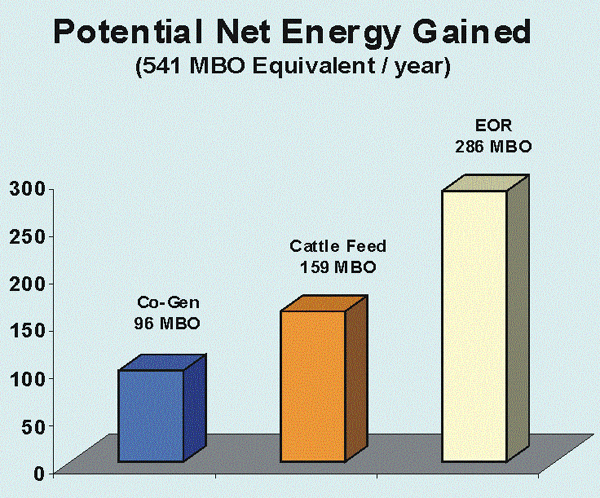
Model for Environmentally and Economically Sound Linked Energy Systems
Kansas Geological Survey
Open-file Report 2002-6

|
Model for Environmentally and Economically Sound Linked Energy Systems |
Kansas Geological Survey Open-file Report 2002-6 |
|
(3.1 Trillion BTUs) |

|
| Co-Generation | MMBTU | Barrels Oil Equiv. | |||
| Steam | 462,300 | MMBTU/Year | |||
| DDG Dryer | 96,360 | MMBTU/Year | |||
| (assumes co-gen running at 100%) | |||||
| Net energy saved by using co-gen heat | 558,660 | 96,321 | |||
| Cattle Feeding | |||||
| Distillers' Dried Grains Produced | 167,910,448 | lbs/year | |||
| Grain Corn Equivalent (by weight) | 263,619,403 | lbs/year | |||
| (1 lb. DDG is equivalent to 1.57 lbs. Corn) | |||||
| Grain Corn Equivalent (by volume) | 4,707,489 | Bushels/year | |||
| Grain Corn Equivalent (Acreage) | 62,685 | Acres/year | |||
| Energy conversion factor, Russell Co., KS | 14,695 | MBTU/acre | |||
| Net energy saved by offsetting corn acreage | 921,145 | 158,818 | |||
| Enhanced Oil Recovery | |||||
| Carbon Dioxide Generated (lbs) | 165,600,000 | lbs/year | |||
| (Tons) | 82,800 | tons/year | |||
| (MCF) | 1,426,644 | MCF/year | |||
| CO2 Utilized (MCF) (90%) | 1,283,980 | MCF/year | |||
| Net utilization of CO2 | 4.3 | MCF/BO | |||
| Oil from EOR @ 4.3 MCF CO2/BO | 298,600 | BO/Year | |||
| Energy required (per BO produced) | 78.1 | kwh/BO | |||
| (Dehydrate, compress, pipeline, recycle CO2, plus lifting energy) | |||||
| Energy required (total) | 73,273 | MMBTU/Year | |||
| Energy Value of Oil | 1,731,879 | MMBTU/Year | |||
| Net energy value of oil produced by EOR | 1,658,606 | 285,967 | |||
| Total Potential Energy Gains | 3,138,412 | 541,105 | |||
Co-generation
For the power plant/ethanol plant co-generation, data was provided
by the operators of these facilities. The Russell Municipal power
plant uses two Solar™ Taurus 70 single-cycle gas turbines,
rated at a total 15 Mwe (Augustine, 2001, personal communication).
The turbines' waste heat passes through a heat recovery boiler
that generates steam used to heat the mash at the adjacent United
States Energy Partners Ethanol plant. The waste heat from the
heat recovery boiler is also used by the USEP ethanol plant for
the purpose of drying the Distillers' Dried Grains. The amount
of waste heat used by the USEP facility for each process is shown
in the results.
Cattle Feed
The energy saved for cattle feed was based on the amount of Distillers'
Dried Grains (DDG) produced as a by-product of the Ethanol process.
The by-product of a bushel of milo in the ethanol process creates
18 lbs of DDG (Mork, 2001 personal communication). The energy
value of the DDG was calculated by determining how much energy
would be used to create a substitute for DDG, which in this case
was grain corn at the rate of one pound of DDG replaces 1.57 lbs.
of corn (Delucchi, 1998). Corn weighs 56 lbs. per bushel (EPA,
1985) and in Russell County, Kansas, the average corn crop yield
from 1996-2000 was 75 bushels per acre (KASS, 2001). The energy
required to grow an acre of corn was based on results from Pimentel
(1991) with substitutes of local fertilizer and herbicide data
for Russell County, Kansas and Kansas Region 2, which includes
Russell (KSU, 1998).
Enhanced Oil Recovery (EOR)
The energy gained from Enhanced Oil Recovery (EOR) is that which
is projected in a hypothetical case where the entire CO2 stream
(less 10% for losses) from the Russell ethanol plant is compressed
and piped to a small commercial scale project in the Hall-Gurney
Field. An assumption is made that all CO2 EOR oil is new oil
that would not have otherwise been produced.
Oil recovered per net volume of CO2, 4.3 MCF CO2 per barrel of oil, is that which was determined to be reasonable in the current DOE funded demonstration project. Assuming 90% of the CO2 (3.5 MMCFPD, 1.3 BCF per year) and a 4.3 MCF/BO net utilization, there is potential for 300 MBO per year production. Energy value was calculated on the basis of 5,800 MBTU/barrel (EIA, 2001). The energy used in production includes that related to the CO2, dehydration, compression and transportation via pipeline, injection and recycling, and that related to artificial lift. These were all related to the energy costs per barrel of oil produced (78.1 kWh per barrel of oil). Energy use data to make the calculations were from various industry sources gathered in the DOE project and from Egbert (1996, 2000).
|
|
e-mail : webadmin@kgs.ku.edu
Last updated March 2002
http://www.kgs.ku.edu/PRS/Poster/2002/2002-6/P3-02.html